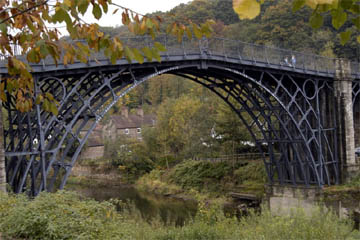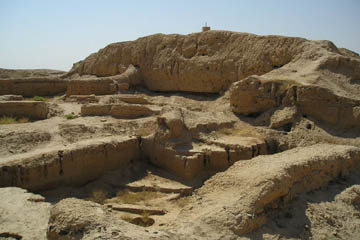Mari - the first Industrial Town
| Mari | 34 33 02.05N 40 53 21.14E | The tel is clearly visible close to the river Euphrates. |
About eighty miles from my home is the new town of Telford, an artificial abomination built with no other purpose but to house the overflow population of the English Midlands. Normally I avoid it like the plague, but from time to time I actually go there, of my own free will: the magnet that draws me is the steep-sided, wooded valley known as Ironbridge Gorge.

It, too, is an artificial town that exploded into being in the late 1700s when Abraham Derby, a local man, invented a new technique for making iron using cheap coke instead of expensive charcoal. The site had the advantage that it was close to sources of coal, iron ore, limestone and water, both for power and transport, and for a time it was the industrial hub of the world.
Today the coal mines are abandoned, the iron ore has run out, power comes from electricity and transport is by road. Ironbridge has lost its advantages and only survives as a tourist mecca for those attracted to its famous and iconic bridge. Its only industry is the large open-air museum that utilises the old factories to tell the story of the dawn of the real Iron Age.
French archaeologist Jean-Claude Margueron believes that the city of Mari had a similar history.
In 1933 Arabs digging a grave on a deserted hillside above the Euphrates River were astonished when a little stone man emerged from the soil. They reported the matter to the nearest police post - which was manned by French soldiers because Syria was under French mandate at the time. Lieutenant Cabane, who was in charge of the post, sent off reports to his superiors and to the museum in Aleppo. He was astounded when, in December of that year, a high-power party of archaeologists and experts from the Louvre arrived and demanded to be shown the statue and the find site.

Tel Hariri proved to be a gold mine of ancient sculpture and cuneiform tablets and for the next six years Professor Parrot dug there, discovering as he did so that he was excavating the famous city of Mari, the tenth city to be founded after the Flood, mentioned in numerous inscriptions found in other places. By the time they had finished the archaeologists had uncovered many buildings including temples and the vast palace of the kings of Mari that covered nearly ten acres! Among its ruins they found more than 23,600 cuneiform tablets, the royal archives of Mari.
Professor Margueron has been director of excavations at Mari since 1979 and under his management the work of clearing the city has been going on steadily. There have been no more spectacular discoveries, but instead the civilian quarter has been explored - little houses, a warren of streets, and dozens of workshops for smelting copper or turning it into finished products.
It is this last which has surprised Margueron. Mari is far from any sources of copper ore, from the forests which supplied fuel and, indeed, from the markets where copper objects and weapons might be required. Yet metal work seems to have been the rationale for Mari's existence, for although it stands on the Euphrates, the surrounding area is desert and there was no large agricultural area to serve as a foundation for a prosperous city-state.
As well as excavating the city, Margueron and his team have explored the surrounding area and identified the remains of a large canal which ran for 75 miles towards the Tauras Mountains of southern Turkey, where abundant copper ore and wood could be found. Other canals supplied water to the surrounding plain to allow a certain amount of agriculture while another brought boats inside the protective flood levy that surrounded the city.
His conclusion is that Mari was deliberately built for the sole purpose of working copper. Equidistant between the markets of Mesopostamia and Syria, close - but not too close - to the rich natural resources of the mountains, protected by the surrounding desert, Mari was an industrial city as artificial and deliberate as Ironbridge.
Alas, that is far too simplistic a view. Like Palmyra, Mari was situated on important trade routes, both along the river and across the desert. The Mari tablets speak of trade in dates, olives, pottery, porcelain and grains, as well as timber and stone which were brought from the Tauras Mountains and sent on to Mesopotamia where both were in great demand.
Professor Margueron is correct in this respect, however, in that once Hammurabi had destroyed Mari, the city quickly declined. Traders were encouraged to use alternative routes, other cities took over the metal-working, there was no longer the finance or the manpower to maintain the canals, and the city died.
© Kendall K. Down 2009





